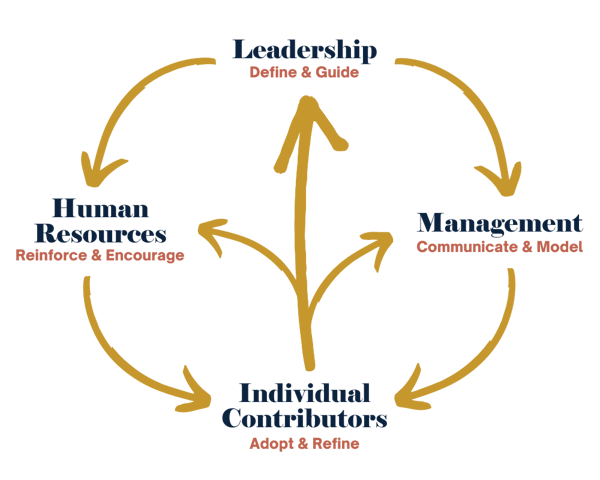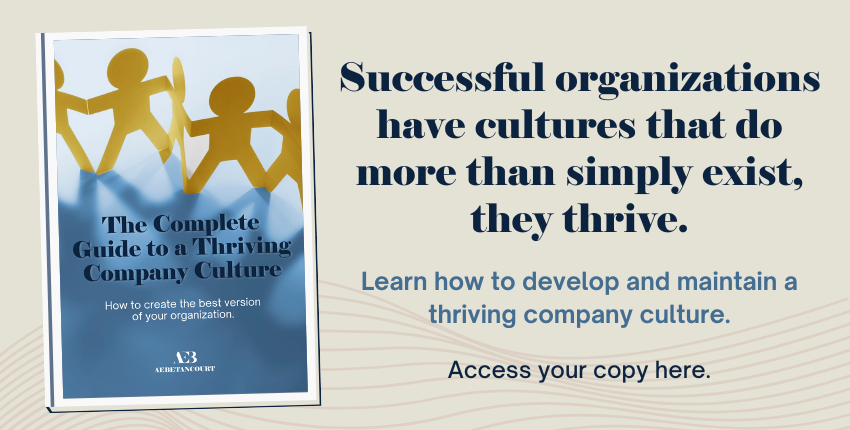When it comes to corporate culture, it is often difficult to define and much harder to build. Culture is commonly understood as the collective behavior, attitudes, and beliefs of individuals within an organization. It encompasses both formally stated norms and the implicit ways in which people collaborate and engage with one another.
Too often there is a gap between the existing culture at an organization and it's “desired” culture. For many organizations, corporate culture is an amorphous concept that everyone influences but no one truly leads or is held accountable for. Where does the responsibility of corporate culture lie? Who takes the lead? And why does it even matter?
The ideal answer to who is responsible is everyone, at various levels and roles — individual contributors, managers, HR, senior leadership, and owners — within your organization can, and should, contribute to the workplace culture. Therefore everyone is responsible for creating and maintaining a positive environment.
But this mindset won’t come without some pushback. There are conflicting opinions on who “owns” workplace culture. The Workforce Institute at Kronos found that 40% of employees said that they define culture, 33% of HR professionals said they define culture, 26% of managers said the executive team should define culture, and finally, 28% of employees said no one actually defines workplace culture.
But, the short answer really is everyone. Everyone is responsible for the corporate culture fostered within an organization. In this blog, learn why everyone needs to be accountable for the corporate culture, how each department and individual position is responsible, and the positive impacts of corporate-wide responsibility.
Why Corporate Culture Requires Company-wide Involvement
Corporate culture requires company-wide involvement because different roles will help to define and develop an inclusive culture. It will happen through both formal and informal spheres of influence, which means no one group or role can be held responsible for the whole of the culture.
Human Resources is commonly tasked with the responsibility, but your organization’s culture goes far beyond being just an HR issue. Attributing the responsibility of culture solely to HR creates a significant challenge for the department. Although HR leaders are often regarded as the default custodians of organizational culture, success hinges on achieving widespread buy-in throughout the entire company. A company’s culture is the result of everyone’s behavior. Employees and leadership alike — among various levels and roles — are responsible for fostering a positive workplace culture.
And let it be known, evolving your company culture is a difficult task that will require time, work, and consistency. It will demand a collective effort with clear roles and responsibilities. And company-wide buy-in will reflect how the organization actually operates.
How Each Area of Your Organization is Responsible for Corporate Culture
Corporate Leadership
Your company’s corporate leadership, including the Board of Directors, CEOs, and owners, plays a large role in guiding and defining the culture. Your leadership is already responsible for advancing the company’s purpose and core values, but they should ensure that the core values are also present in the corporate culture. Leadership should guide the definition and development of the desired culture and ensure that it aligns with overall business goals. Defining and cultivating a desired culture happens through leadership actions which include setting objectives, strategies, and KPIs that prioritize culture-building
Human Resources
Your Human Resources department will need to reinforce and encourage your company’s desired workplace culture. This will happen through the design of employee experiences that align with your culture and the implementation of strategies and programs that enable employees to fulfill their cultural responsibilities. This could range from training programs that develop leaders, employee engagement, and even reward and recognition programs.
Management
Every area of your organization plays a part in its corporate culture. Your Management team is integral to communicating and modeling your company’s desired culture and its practices to provide clarity to employees and other individual contributors. This is where the shift from designing and planning the culture turns into action. Managers should help to support and deliver employee experiences that reinforce the corporate culture, implement culture-building strategies, and help employees fulfill them.
Individual Contributors
Individual contributors are the largest group in any organization. These employees aren’t part of senior leadership, your HR department, or mid-level management. However, individual contributors are critical to adopting and refining your corporate culture. They help to create, adhere to, and enforce the routines and norms that fulfill the designed workplace culture. Individual contributors provide feedback on the current state of affairs and input on new culture-building initiatives. Because this group is the most engaged with your corporate culture, they possess unique insight into how closely your ideals and perceptions align with the actual culture and customer perspective notwithstanding employee needs and expectations.
A top-down and bottom-up approach to building corporate culture will drive awareness, adoption, and empathy in your organization. People will see the fruits of their labor as your positive culture flourishes. The goal is to ensure that leadership doesn’t perpetuate a biased view of the corporate culture (which is often framed as better than it actually is) and that everyone else in other areas of your organization will feel connected because they were involved in the culture-building process.
Positive Effects When Everyone Takes Responsibility
Involving people drives interest and excitement, which helps to avoid cultural inertia, an unengaged workforce, or employee apathy. When everyone is responsible and part of the process, there’s a strong sense of ownership and positivity. A healthy corporate culture encourages employee loyalty, productivity, and commitment. There are several other positive effects of culture when everyone has a stake in it.
- Improved employee morale and engagement. When employees feel invested in their workplace, their attitudes and engagement in their work and with their employees can improve.
- Increases open communication and shared ideas. A positive culture ensures a safe space for communication and collaboration.
- Fosters an environment that encourages learning. A corporate culture with organizational buy-in allows employees to take calculated risks and reduce the fear of failure.
- Promotes confidence and personal fulfillment. Employees with a hand in culture-building are more confident and secure in their roles, which leads to increase fulfillment when doing work.
- Reinforces a shared vision for the organization. When everyone is responsible for building a positive corporate culture, the shared vision for the success of the organization is constantly reinforced.
- Builds trust and camaraderie. Positive workplace cultures that are the result of everyone’s intentional effort help build a sense of camaraderie and trust within teams and between departments.
- Drives employee retention. When everyone has a stake in culture-building, it is more likely they will stick around to see it through.
- Establishes accountability. If everyone is responsible for your company’s culture, everyone can be held accountable for whether they are fulfilling their duties.
Sustaining a High-Performing Corporate Culture
Workplace culture matters. The culture of a company drives its success and should be considered the glue between your corporate vision and your people — but not a rigid glue, your culture has to be adaptable. Whatever external pressures or internal changes your organization faces, a sustainable and high-performing corporate culture will be able to keep up.
Your culture will exist either by design or default. It is the combination of assumptions and behaviors that defines the collective attitude. This is why a company’s culture has to be everyone’s responsibility.
From the C-suite to the individual contributors, everyone is accountable for a sustainable and high-performing culture. Yet, to achieve your desired culture, a clear, consistent understanding of it is also required. Each member of your team should have a hand in shaping and influencing your corporate culture. This means everyone will need to work in a deliberate and coordinated effort to cultivate a culture that not only aligns with your corporate vision and strategic efforts but also promotes a positive workplace that drives job satisfaction and retention.


.png)





